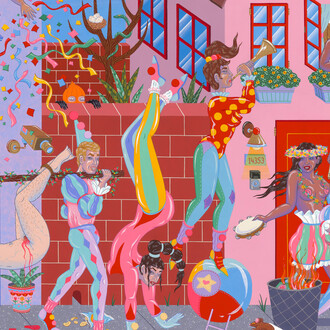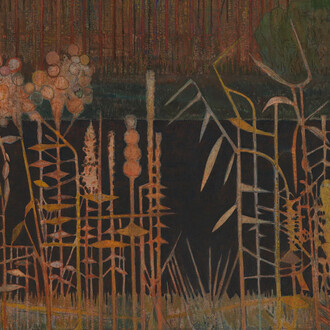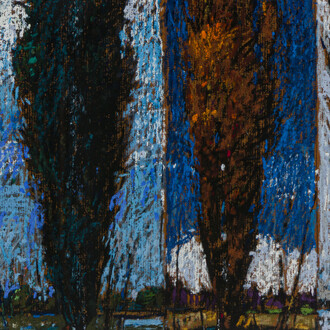The paintings of Andreas Schulze (*1955) and Salvo (1947–2015) depict intriguing worlds unlike any other. Across vibrant landscapes and eccentric interiors, their unique conceptual approaches to painting evolved over decades of experimentation with color, light and form. Monika Sprüth and Philomene Magers are proud to present an exhibition of new works by Schulze alongside paintings by Salvo, bringing into focus their parallel contributions to the discourse of contemporary painting and their deft manipulation of paint to depict shifting spatial and light effects. The exhibition’s presentation at the Los Angeles gallery brings into focus this particular concern with light and space—a feature so prevalent in the history of modern art in Southern California, from its impressionist, plein-air roots to the reflective plastics and resins of the 1960s onward.
Born Salvatore Mangione, Salvo came of age as an artist in Turin in the 1960s, home to the vibrant avant-garde scene that birthed the Arte Povera movement. He was close with Alighiero Boetti, and moved in circles alongside Mario Merz, Giuseppe Penone and Gilberto Zorio, developing his own conceptual practice often with text at its basis. Despite receiving recognition for this work, including participation in Documenta 5 (1972) and solo exhibitions, in 1973 Salvo made a radical departure and embraced oil painting in a style that looked to traditional art histories from Giotto and Botticelli to Italian Futurism and Surrealism. Using bright, contrasting colors that reveal their artifice, Salvo managed to infuse his landscapes and cityscapes with resplendent light effects that seem true to life, if also dreamlike and perpetually still.
Andreas Schulze has played a key role in German painting for over four decades. Like Salvo, he was a participant in the heady artistic dialogues around him—in Schulze’s case, Die neuen wilden (The new fauves) of Cologne’s Mülheimer Freiheit group. Yet he developed his own distinctive painterly methods that balance representation and abstraction, adopting styles derived variously from Surrealism, Pop Art and Abstract Expressionism and infusing his scenes of everyday bourgeois life with humor and irony, as well as an intermittent sense of foreboding. At every turn, Schulze both celebrates and defamiliarizes his domestic scenery, urban tableaux and lush landscape views, rendering them strange and absurd through his particular treatment of paint and compositional space.
In Schulze’s Untitled (Black cloud) (2024), for example, flowing diagonal bands cut through the sides of the work, pouring down its surface in a nod to Abstract Expressionist painter Morris Louis’ celebrated “Unfurled” canvases. This hyperreal, graphic rendition of Color Field painting is filtered through Schulze’s characteristic delineations of black, white and color, which give way to a more abstract, amorphous background reminiscent of Helen Frankenthaler’s pours and stains. Schulze plays overtly with our desire to spot figuration in even the most abstract passages, with the “black cloud” of the work’s title hanging sinisterly over a pale yellow horizon.
Salvo’s La città (2013) also lays bare the artist’s historical precursors, specifically De Chirico, with its enigmatic city view and its palette of brown, gold, green and red echoing that of the Surrealist master. Like Schulze, Salvo depicts scenes from everyday life—in this case, a bus or tram moving through town at night. Both artists revel in simple things, and reduce everything down to its most concentrated form according to geometrical systems all their own. In Schulze’s large-scale diptych Untitled (Much) (2025), the artist takes this to a literal conclusion: blue cubic forms emerge from a brown, box-like opening at the center of the composition, seeming to float, gravity-free, toward the viewer.
Each artist, in his own way, tends to collapse foreground and background—a flattening out that can sometimes expand dramatically into physical depths. This mixed sense of space is present in Salvo’s Ottobre (2000): in the foreground, trees sit on rolling hills, shaded on the left, and glowing brilliantly in the midday sun on the right. A trio of houses of varying sizes emphasize spatial recession, as do purple mountains in the background; yet clouds of a similar scale appear both behind and in front of the mountains, setting up an impossible perspective. Works such as Schulze’s Untitled (Cabinet with curtain) (2024) illustrate a similar flattening and expansion of space in his work, just as it reveals one of his recurring tropes: the curtain and the stage.
Salvo’s ability to capture light effects is clear in a work such as Mediterraneo (2008), which features the artist’s characteristic Sicilian vegetation and seaside views. His juxtaposition of dark muted greens, burnt oranges and rich golden yellows, together with a patch of light turquoise in the lower right, manages to capture the resplendent feeling of sunset. Together with his frequent references to seasons and times of day in his titles, Salvo’s paintings invariably evoke dreamlike narratives and the passage of time. And though humans are conspicuously absent in his and Schulze’s work, they are usually implied—through Schulze’s curtains and the twisting forms in Untitled (Dance dance dance) (2025), for example, or the domestic architectures and manicured vegetation that populate Salvo’s scenes.
Working at similar moments in time—though Salvo’s career ended with his death in 2015—both artists fully embrace painting, not trying to deconstruct or reimagine the medium as other contemporaries have done, but rather using it to instigate and reinvigorate our understanding of the world through color, light, texture and mood.
















